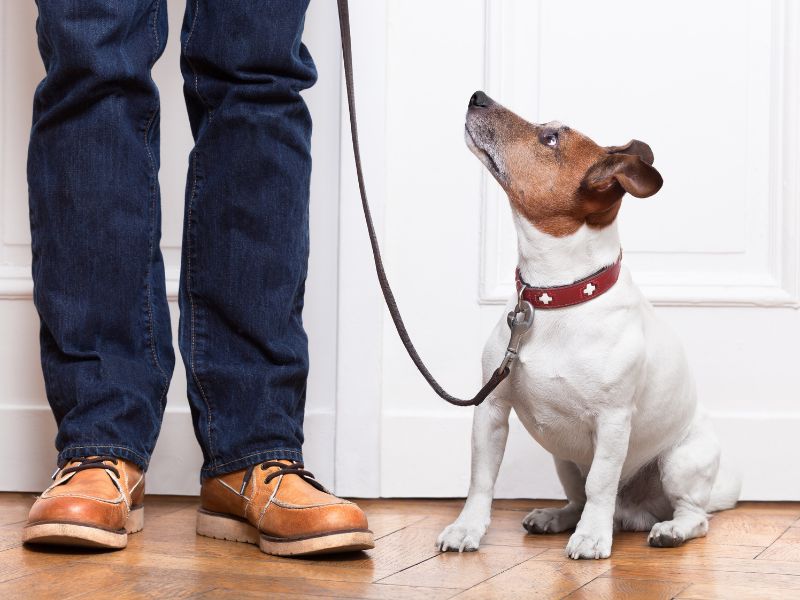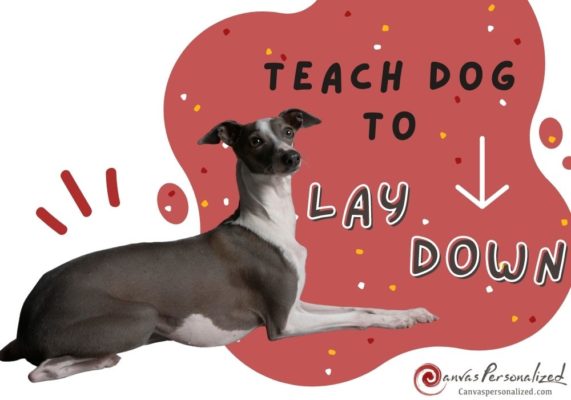Tired of your daily walks turning into an arm-wrestling match with your furry friend? Mastering how to teach a dog to heel can transform those frustrating tugs and pull into an experience of obedience and joy. Imagine strolling side-by-side, your dog walking politely at your pace, perfectly in sync with your every move. In this comprehensive guide, Canvas Personalized will take you through a step-by-step guide with troubleshooting tips and expert advice to help you have stress-free walks with your canine companion.
What You’ll Need When Training
- Leash
A standard 6-foot leash is ideal for heel training. Avoid retractable leashes, as they can give your dog too much freedom and make it harder to maintain control. Look for a leash made from durable material that’s comfortable to hold.
- Collar or harness
Choose a well-fitting collar or harness that’s comfortable for your dog. A flat collar is often suitable, but if your dog tends to pull, a front-clip harness can help redirect their attention and discourage pulling.
- High-value treats
When training, especially for new or tricky commands, use high-value treats that get your dog’s full attention. Bite-sized pieces are ideal for frequent rewards without upsetting their diet. For stubborn pups or smaller breeds where bending down might be tricky, consider using a long-handled spoon coated in a spread like peanut butter, cream cheese, or even wet dog food.
- Clicker (optional)
If you’re familiar with clicker training, a clicker can be a useful tool for marking desired behaviors and providing immediate feedback to your dog.

How to Teach a Dog to Heel on a Leash
Training your puppy or older dog to walk by your side can be an enjoyable experience. Your dog will learn to heel with the help of this easy-to-follow guide.
Step 1: Choose a training ground
Pick a quiet area with minimal distractions for your initial training sessions. Your living room or a fenced-in backyard are good options. If you start in a bustling environment, even the tastiest treats might struggle to compete with all the excitement.
Step 2: Position your dog and reward
Hold a treat in your hand close to your side, where you want your dog to heel (either side you choose, but traditionally, the left side is considered the heel side). Lure your dog into position beside you, with their shoulder aligned with your leg. As soon as they’re in the correct position, say “yes” or click your clicker (if using) and give them the treat. Repeat this several times.
Step 3: Introduce the “Heel” cue
Once your dog consistently moves into the heel position when lured, start saying the word “heel” just as they reach the correct spot. The goal is to associate the word “heel” with the action of walking beside you.

Step 4: Add distance
Once your dog understands the “heel” cue, start taking a few steps forward while repeating the cue and rewarding them for staying in position. Gradually increase the distance and duration of your walks, always rewarding your dog for maintaining the heel position.
Step 5: Add distractions
As your dog gets better at heeling in a quiet environment, gradually introduce distractions. Practice heeling in different rooms of your house, then move to your yard and eventually to busier areas like parks or sidewalks. Increase the level of distraction slowly, always rewarding your dog for staying focused.
Step 6: Taper off treats
As your dog becomes more proficient at heeling over longer distances, you can gradually phase out the use of treats. Start by increasing the distance between rewards and offering fewer treats over time. Eventually, your dog should be able to reliably heel with minimal or even no treats at all.
>> Read more: How To Teach A Dog To Stay In 7 Steps?
Troubleshooting Tips for Common Challenges
A common misstep in dog training is rushing to the next stage before your dog has fully mastered the previous one. This can make it seem like your dog has forgotten previous lessons. If your dog starts making repeated mistakes, rewind a bit – increase the frequency of treats and shorten the distance you’re walking. Take it slow and gradually rebuild your dog’s confidence and skill until they’re ready to heel for longer stretches again.

In addition, pay close attention to your dog’s body language. With practice, you’ll be able to anticipate when they’re about to break from the heel position. Notice subtle cues like muscle tensing or fixating on distractions. If you see these signs, promptly give the “heel” command and change direction to regain their focus. This teaches your dog to stay attentive to you and your commands.
Additional Tips for Teaching a Dog to Heel
- Keep training sessions short: Dogs have short attention spans, so aim for multiple short training sessions (5-10 minutes) throughout the day rather than one long session.
- Be Patient and Positive: Heeling is a complex skill for dogs, so be patient and understanding. Stay positive, use plenty of praise and rewards, and don’t get discouraged if your dog doesn’t get it right away.
- Consistency is Key: Use the same verbal cue (“heel”) and hand signal (if using) every time. Be consistent with your rewards and expectations.
- Don’t Punish Mistakes: If your dog makes a mistake, simply redirect them back to the heel position and continue practicing. Avoid scolding or punishment, as it can make your dog anxious and less willing to learn.
- Vary Your Rewards: While treats are essential in the beginning, gradually introduce other forms of rewards like verbal praise, petting, or a favorite toy. This will keep your dog motivated and prevent them from becoming solely food-driven.
- Keep it Fun: Make training sessions enjoyable for both you and your dog. Use a cheerful tone of voice, offer plenty of praise and affection, and incorporate games or challenges to keep things interesting.
>> Further reading: 15 Best Dog Training Tips & Why Teaching Dogs is Important?

FAQs About Training A Dog To Heel
How long does it take to teach a dog to heel?
Most dogs will understand the heel command within 1-2 weeks of consistent training. However, mastering the skill and heel by your side reliably in various environments can take several weeks or even months. If he’s a slow learner and training is inconsistent, it may take 2 to 3 months.
Should a dog heel the entire walk?
No, a dog shouldn’t heel for the entire walk. While heeling is an important skill for safety and control, it’s also essential for dogs to have opportunities to sniff, explore, and simply be dogs. A good balance is to alternate between heeling and loose-leash walking, allowing your dog to enjoy some freedom while still maintaining basic manners.
What age to teach a dog to heel?
Training a dog to heel can begin as soon as your furry friend arrives home. I typically start training the heel command for my dogs when they are between 8-12 weeks old. Even though a pup this young might not fully understand the concept, you can start shaping their behavior by rewarding them with treats for walking close beside you.

>> Another related post that you may want to read:
- How To Teach A Dog To Roll Over Quickly In 3 Easy Parts?
- Easy Way To Teach Your Dog To Lay Down For Beginners (2022)
Congratulations! You’re now equipped with the knowledge and skills to embark on the rewarding journey of how to teach a dog to heel! Remember, patience, consistency, and positive reinforcement are the keys to success. Celebrate every milestone, no matter how small, and embrace the process of learning together. Canvas Personalized believes that with dedication and practice, you’ll soon be confidently strolling side-by-side with your canine companion.










